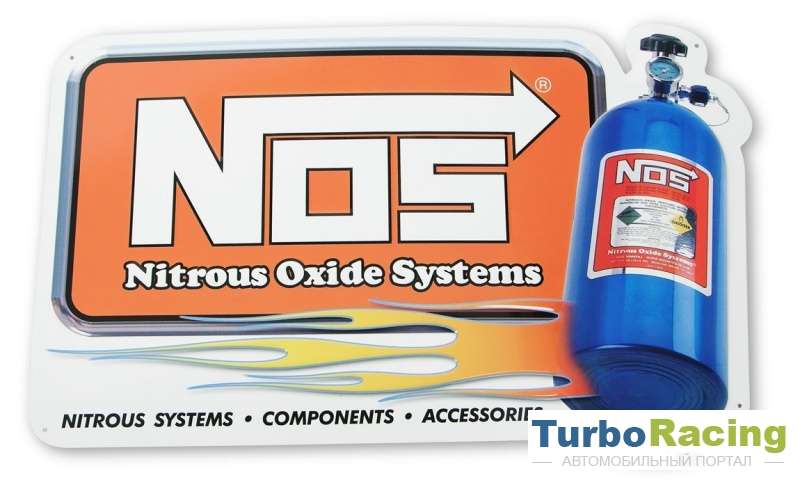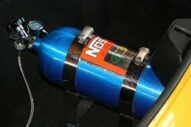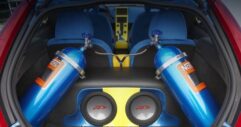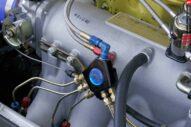
Nitrous Oxide N2O - Applications and Functions
Content
Nitrous oxide - chemical element N2O, which has been widely used in motorsport. Thanks to this mixture, automotive engineers were able to increase the engine power from 40 to 200 hp, depending on the type and structure of the engine being tuned.
NOS - nitrous oxide system
NOS stands for Nitrous Oxide System.

NOS - nitrous oxide system
The real popularity of nitrous oxide came after its use in motorsport, namely in Drag Racing. People rushed to shops and service centers, determined to increase the power of their iron horse. Thanks to this, the records of passing a quarter of a mile (402 meters) were broken, cars left in 6 seconds, and their exit speed exceeded 200 km / h, which was previously not possible.
Let's consider the main types of nitrous oxide systems.
“Dry” nitrous oxide system
The simplest solution of all is that a nozzle is mounted in the intake manifold, which will be responsible for supplying nitroxide. But here we are faced with a problem - the mixture is not corrected, more air is supplied than fuel, therefore the mixture is poor, from where we get detonation. In this case, you have to modify the fuel system by increasing the opening impulse of the nozzles or increasing the pressure in the rail for the fuel supply (in the case of carburetor engines, it is necessary to increase the nozzle flow area).
“Wet” nitros system
The design of a “wet” system is much more complicated than a “dry” one. The difference lies in the fact that an additional embedded nozzle not only injects nitrous oxide, but also adds fuel, thereby making the mixture with the right ratio of air and oxygen. The amount of injection of nitrous and fuel substances is determined by a controller specially designed for NOS systems (by the way, when installing this system, no settings need to be made in the car's standard computer). The disadvantage of this system is that it is required to carry out an additional fuel line, which makes the task quite laborious. “Wet” systems are well suited for engines that have forced air injection using a turbocharger or compressor.
Direct injection system

Nitrous oxide direct injection system
A modern and powerful option, it is implemented by feeding nitrous oxide into the intake manifold, but at the same time, the supply of nitrous oxide to each cylinder occurs separately, by means of separate nozzles (by analogy with a distributed fuel injection system, but only for nitrous oxide). This system is very flexible in setting, which gives it an undeniable advantage.
Scientific substantiation of the work of nitrous oxide
It's probably no secret to anyone that any internal combustion engine runs on a fuel-air mixture. However, the air around us contains only 21% oxygen and 78% nitrogen. The normal fuel mixture ratio should be 14,7 to 1 those. 14,7 kilograms of air per 1 kilogram of fuel. changing this ratio allows us to introduce the concept of a rich and lean mixture. Accordingly, when there is more air than required, the mixture is called poor, on the contrary, rich. If the mixture is poor, then the engine starts to triple (not run smoothly) and stall, on the other hand, with a rich mixture, it can similarly flood the spark plugs and then the engine will also stop.
In other words, filling the cylinders with fuel will not be difficult, but burning all this is problematic, since fuel burns badly without oxygen, and as we discussed earlier, you cannot collect much oxygen from the air. So where do you get oxygen from? Ideally, you could carry a bottle of liquefied oxygen with you, but in practice this is deadly. In this situation, the nitrous oxide system comes to the rescue. Once in the combustion chamber, the nitrous oxide molecule breaks down into oxygen and nitrogen. In this case, we get much more oxygen than when taken from air, since nitrous oxide is 1,5 times denser than air and contains more oxygen.
With all its advantages, this system has an equally significant disadvantage. It consists in the fact that none the motor will not be able to withstand a long-term injection of nitrous oxide without significant modificationsas operating temperatures and shock loads rise sharply. As a rule, the injection of nitrous oxide is short-term and is 10-15 seconds.
Practical results of using nitrous oxide
It is clear that drilling the intake manifold is not easy and requires certain skills and experience, but if everything is done correctly, then the installation of a nitrogen injection system practically does not reduce the engine resource, however, if your engine has any wear or mechanical damage, then the increase in power due to nitrous oxide will quickly bring them to a major overhaul.

Nitrous oxide system kit
What increase in power can nitrous oxide N2O give?
- 40-60 h.p. for motors with 4 cylinders;
- 75-100 HP for motors with 6 cylinders;
- up to 140 hp with a small cylinder head and from 125 to 200 hp with large cylinder head for V-shaped engines.
* results taking into account what is different engine tuning was not carried out.
If you are not using a dedicated nitrous oxide injection system, then for maximum results, nitros must be turned on in last gear with maximum throttle at 2500 - 3000 rpm.
When using a nitros system, check the spark plugs. they can report detonation in cylinders if fuel is low. In the case of detonation, it is advisable to reduce the size of the nitrous oxide injector, install plugs with a thicker electrode and check the pressure in the fuel line.
When using a nitrous oxide injection system, the main thing is not to overdo it, because otherwise you can easily kill your engine or any other component very easily. Get down to business wisely and you will build a real power unit.
Happy tuning!
Questions and answers:
Can I put nitrous oxide in my car? It is possible, but the effect of such an installation lasts only a couple of minutes (depending on the volume of the cylinders). This gas is not used as the main fuel, since its consumption is very high.
How much power does nitrous oxide add? Without major modifications to the engine, the use of nitrous oxide can add 10-200 horsepower to the engine (this parameter depends on the performance of the engine and the installation features).
What is nitrous oxide used for? In cars, this gas is used to temporarily boost the horse's engine, but the main purpose of nitrous oxide is medicine (an anesthetic called laughing gas).
